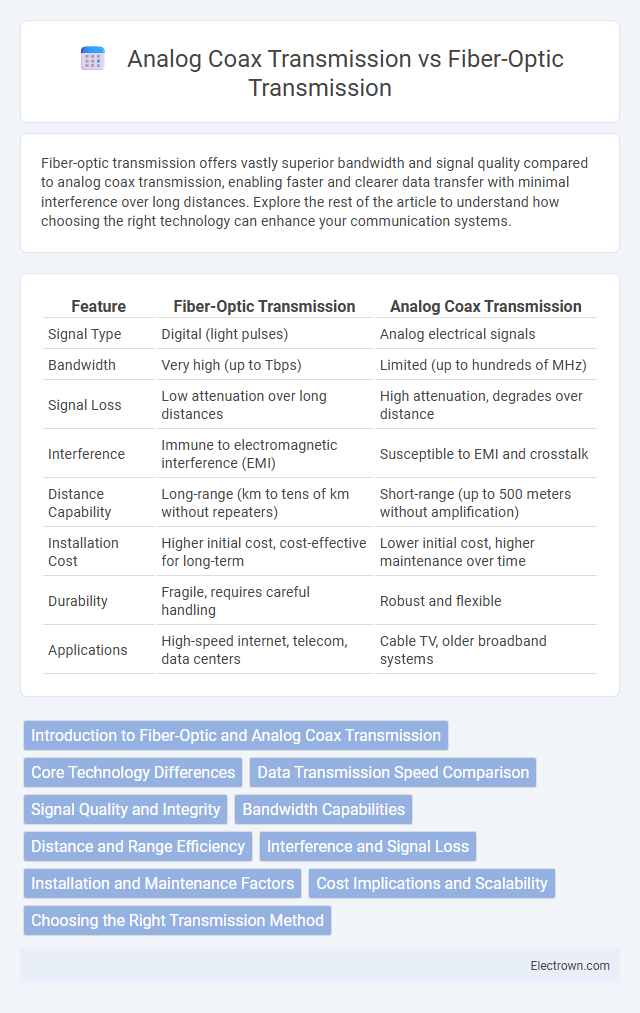Fiber-optic transmission offers vastly superior bandwidth and signal quality compared to analog coax transmission, enabling faster and clearer data transfer with minimal interference over long distances. Explore the rest of the article to understand how choosing the right technology can enhance your communication systems.
Table of Comparison
| Feature | Fiber-Optic Transmission | Analog Coax Transmission |
|---|---|---|
| Signal Type | Digital (light pulses) | Analog electrical signals |
| Bandwidth | Very high (up to Tbps) | Limited (up to hundreds of MHz) |
| Signal Loss | Low attenuation over long distances | High attenuation, degrades over distance |
| Interference | Immune to electromagnetic interference (EMI) | Susceptible to EMI and crosstalk |
| Distance Capability | Long-range (km to tens of km without repeaters) | Short-range (up to 500 meters without amplification) |
| Installation Cost | Higher initial cost, cost-effective for long-term | Lower initial cost, higher maintenance over time |
| Durability | Fragile, requires careful handling | Robust and flexible |
| Applications | High-speed internet, telecom, data centers | Cable TV, older broadband systems |
Introduction to Fiber-Optic and Analog Coax Transmission
Fiber-optic transmission uses light signals through glass or plastic fibers, enabling high-speed data transfer, superior bandwidth, and minimal signal loss over long distances. Analog coax transmission relies on electrical signals through coaxial cables, which are more susceptible to interference and signal degradation, limiting transmission quality and range. Choosing fiber-optic technology enhances the reliability and clarity of your communication systems compared to traditional analog coaxial methods.
Core Technology Differences
Fiber-optic transmission relies on light signals traveling through glass or plastic fibers, enabling high-speed data transfer with minimal signal loss and immune to electromagnetic interference. Analog coax transmission uses electrical signals through copper cables susceptible to noise, signal degradation, and limited bandwidth compared to fiber optics. Choosing fiber-optic technology enhances Your network's capacity and reliability, making it ideal for modern high-demand communication systems.
Data Transmission Speed Comparison
Fiber-optic transmission delivers data speeds up to 100 Gbps or more, significantly surpassing analog coax transmission, which typically maxes out at around 1 Gbps in optimal conditions. The use of light signals in fiber-optic cables allows for faster and more reliable data transfer with lower latency and minimal signal degradation over long distances. Your network performance will greatly benefit from fiber-optic technology, especially in environments demanding high bandwidth and fast data communication.
Signal Quality and Integrity
Fiber-optic transmission offers superior signal quality and integrity compared to analog coax transmission due to its immunity to electromagnetic interference and minimal signal loss over long distances. Fiber-optic cables maintain data fidelity by using light pulses that resist attenuation and distortion, ensuring clearer and more reliable communication. In contrast, analog coax transmission experiences significant signal degradation and noise, limiting bandwidth and reducing overall transmission quality.
Bandwidth Capabilities
Fiber-optic transmission offers significantly higher bandwidth capabilities compared to analog coax transmission, supporting data rates that can exceed multiple terabits per second. Your network performance improves with fiber optics due to its ability to carry vast amounts of data over longer distances with minimal signal loss. In contrast, analog coax cables have limited bandwidth, typically capping at a few hundred megahertz, which constrains data throughput and overall transmission quality.
Distance and Range Efficiency
Fiber-optic transmission significantly outperforms analog coax transmission in distance and range efficiency, supporting data transmission over tens of kilometers without signal degradation due to minimal attenuation and electromagnetic interference. Analog coaxial cables typically experience signal loss and noise after a few hundred meters, requiring repeaters for extended distances, which increases cost and complexity. The greater bandwidth capacity and lower signal attenuation of fiber-optic cables enable higher-quality transmissions over longer distances, making them ideal for modern communication networks.
Interference and Signal Loss
Fiber-optic transmission offers superior resistance to electromagnetic interference compared to analog coax transmission, ensuring cleaner signal delivery over long distances. Signal loss in fiber optics is significantly lower due to the use of light signals traveling through glass or plastic fibers, while analog coax cables suffer from higher attenuation and signal degradation. Your network's reliability and performance benefit greatly from fiber optics' minimal interference and reduced signal loss.
Installation and Maintenance Factors
Fiber-optic transmission requires specialized skills for installation due to the need for precise splicing and handling of delicate glass fibers, while analog coaxial cable installation is generally more straightforward with standardized connectors and less sensitivity to handling. Maintenance of fiber-optic systems involves monitoring signal integrity with advanced testing equipment like OTDR, often leading to lower signal degradation and longer intervals between repairs compared to analog coax systems that may suffer from electromagnetic interference and require more frequent troubleshooting. The overall lifecycle cost of fiber-optic transmission tends to be lower despite higher initial installation expenses due to reduced maintenance needs and better long-term performance.
Cost Implications and Scalability
Fiber-optic transmission offers lower long-term cost implications due to its higher bandwidth capacity and reduced need for frequent upgrades compared to analog coax transmission, which often incurs higher maintenance and infrastructure expenses. Scalability is a significant advantage of fiber optics, allowing seamless expansion to accommodate growing data demands without substantial additional investment, whereas analog coax systems are limited by signal degradation over distance and require costly signal boosters to scale effectively. Your choice impacts future-proofing, with fiber-optic networks providing a more economically scalable solution for modern high-speed data transmission needs.
Choosing the Right Transmission Method
Fiber-optic transmission offers significantly higher bandwidth and longer distance capabilities than analog coax transmission, making it ideal for high-speed data and video streaming needs. Analog coax transmission, while limited in range and susceptible to signal degradation, remains cost-effective for shorter distances and legacy systems. Your choice should depend on the required signal quality, transmission distance, and budget constraints, with fiber-optic emerging as the superior long-term investment for scalability and performance.
Fiber-optic transmission vs analog coax transmission Infographic

 electrown.com
electrown.com